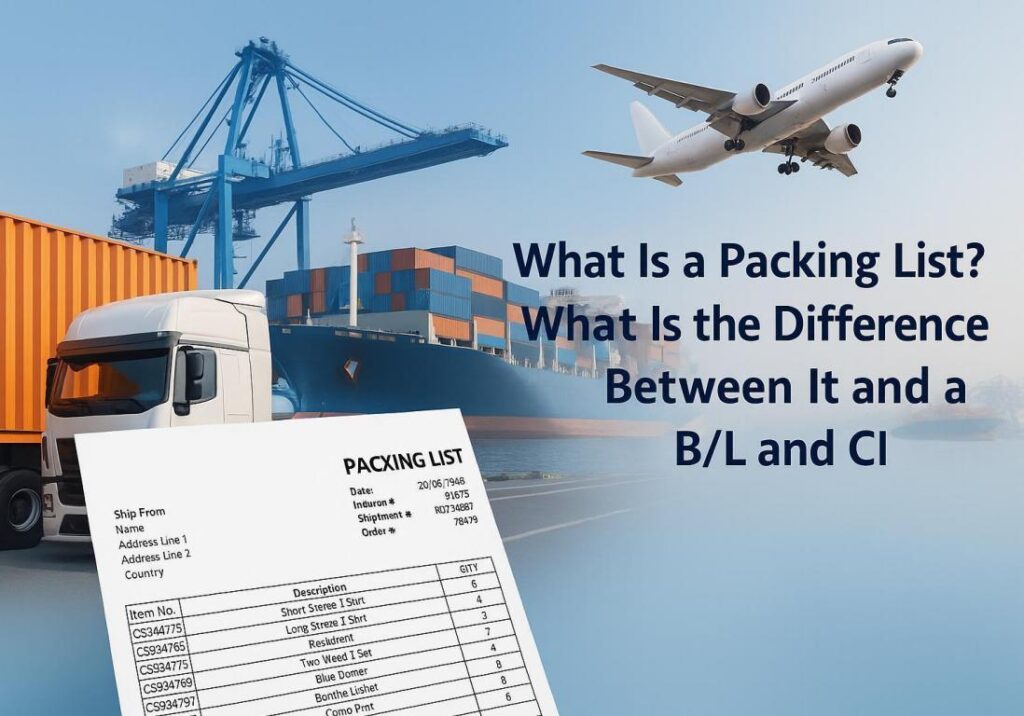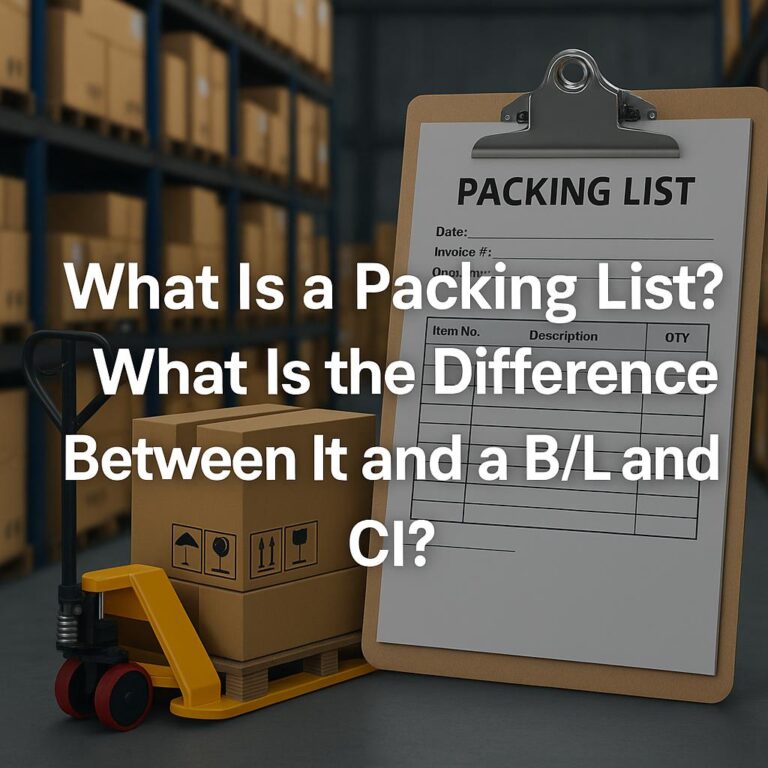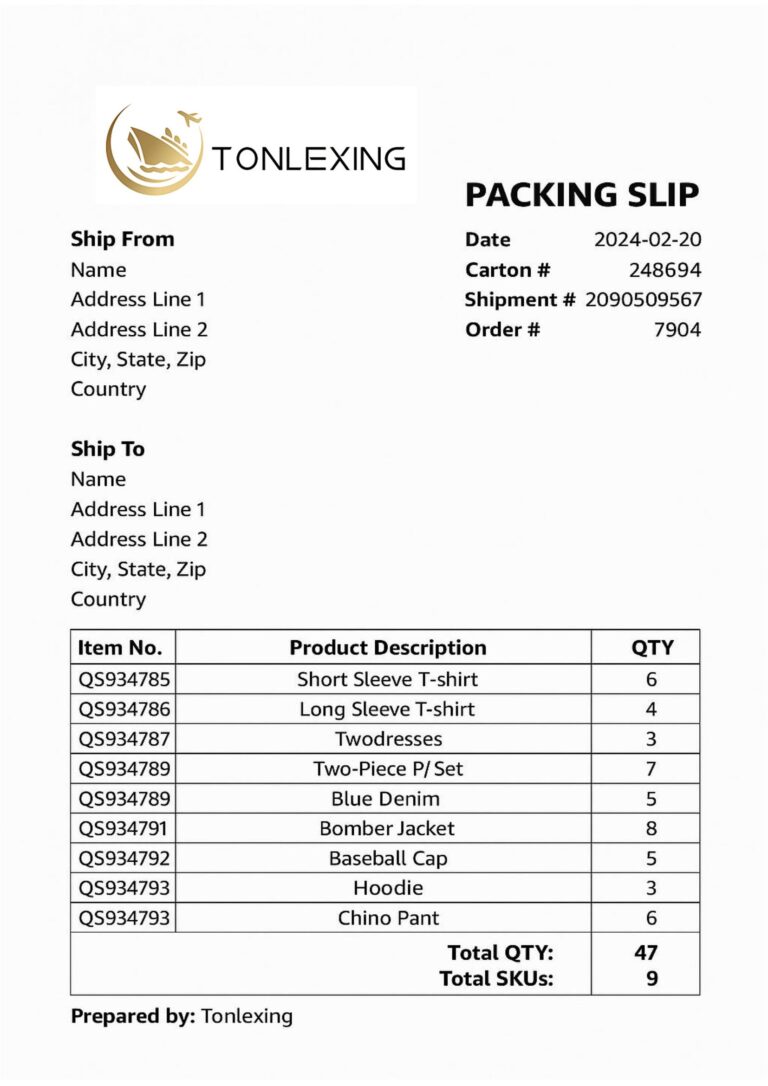What is a packing list? What is the difference between it and a B/L and CI? In international trade, proper documentation is key to ensuring a smooth and efficient shipping process, minimizing delays, and achieving timely delivery of goods. Whether goods are being shipped by air, sea, or land, the accuracy and completeness of shipping documents play a critical role in preventing misunderstandings, customs issues, or financial disputes.
Among the most essential documents used in global logistics operations are the packing list, the bill of lading (B/L), and the commercial invoice (CI). These three documents work together to facilitate communication between exporters, importers, freight forwarders, and customs officials, while also supporting the physical and legal movement of goods across borders.
Each document plays a unique role in the customs clearance process and international transportation. The packing list provides a detailed description of the items shipped, the bill of lading functions as a legal document and receipt of goods, and the commercial invoice outlines the transaction details, such as pricing, terms of sale, and payment terms.
This guide will explain in detail what a packing list is, its key components, and how it differs from other core shipping documents such as the B/L and the CI. Understanding these distinctions is crucial for anyone involved in international transactions, including exporters, importers, logistics professionals, and customs brokers.

What Is a Packing List?
A packing list—also referred to as a shipping packing list, packing slip, or container packing list—is a supporting document used in international trade that provides a comprehensive, itemized breakdown of the goods included in a shipment. While it is not considered a legal document, it remains one of the most vital documents in global logistics for coordinating cargo handling, verifying contents during customs inspections, and assisting in inventory control.
The packing list accompanies the shipment throughout the transportation chain and is used by freight forwarders, customs officials, warehouse operators, and logistics companies to match physical cargo with official shipping documents. It plays a key role in the customs clearance process, particularly when authorities need to inspect goods to assess whether they meet import conditions or preferential trade agreements.
Key Elements of a Detailed Packing List:
Exporter and importer (consignee) names – to identify the parties involved in the international transaction
Invoice number and date – links the packing list to the commercial invoice for consistency
Shipping date and destination port – critical for scheduling and coordination of delivery
Description of goods – clear product names, SKUs, or serial numbers for customs verification
Quantity, unit price, and product codes – helps customs estimate value, even if pricing is excluded
Gross weight and net weight – important for calculating freight charges and balancing container loads
Dimensions and number of packages – used for container loading and warehouse planning
Packaging method and type – such as cartons, drums, or pallets, for proper handling and storage
Any special instructions or key reference numbers – including PO number, batch codes, or handling notes
In some cases, a neutral packing list—one that omits pricing, company logos, or brand identifiers—is requested to ensure confidentiality or meet regulatory requirements for certain international transport packing list standards.
Role of the Packing List in International Shipping
Although the packing list is not a legal document issued by a carrier or government body, it functions as a professional document that plays a central role in the international shipping process. It is an indispensable tool for various parties involved in global logistics—particularly freight forwarders, customs officials, and shipping agents—who rely on its contents to manage and inspect cargo efficiently.
A properly formatted international transport packing list helps ensure transparency, avoid miscommunication, and maintain compliance with customs regulations. Here’s how it contributes to the global supply chain:
Verify shipment contents – Confirms that goods listed match what has been physically packed and shipped.
Compare against the commercial invoice – Helps detect discrepancies in descriptions or quantities that could trigger customs delays.
Assist with calculating import duties – Although the packing list does not include prices, it supports valuation during customs clearance procedures.
Identify items during customs inspection – Enables customs officers to locate, examine, or sample specific products listed.
Ensure proper handling and packaging – Includes important details such as packaging method, gross weight, and net weight, aiding in safe loading, unloading, and warehousing.
If a detailed packing list is missing, incomplete, or contains inaccurate information, it can result in shipment delays, increased inspection times, or even penalties from customs authorities. Missing key reference data—such as PO numbers, cargo markings, or package identifiers—can severely impact coordination and delivery timelines, especially in high-volume international transactions.
Thus, having a correct and well-prepared packing list is not just a formality—it’s a critical component of any successful cargo transportation document package.

What Is a Commercial Invoice?
A commercial invoice is a key legal document issued by the exporter (seller) to the importer (buyer), serving as a formal transactional record in foreign trade transactions. It is one of the most important international shipping documents, required by customs authorities in both the country of origin and the destination country.
This document confirms the terms of the sale and provides the financial details of the goods being exported. It is essential for complying with customs regulations, calculating import duties, and facilitating the customs clearance process. Without an accurate commercial invoice, shipments may be delayed, rejected, or subject to penalties.
Commercial Invoice Includes:
Seller and buyer information – Full legal names, addresses, and contact details for both parties.
Invoice number and date – Used to reference the transaction and link related documents like the packing list and bill of lading.
Product description and unit price – Detailed and accurate description of each item, including quantity and SKU or product code.
Total value and currency – The overall commercial value of the goods, expressed in a specific currency (e.g., USD, EUR, CNY).
Import duties basis (FOB, CIF, etc.) – Declares the Incoterms, which determine who is responsible for freight, insurance, and duties.
Destination and delivery terms – Specifies the final destination, port of entry, and terms of delivery agreed upon.
Shipping company and mode of transport – Identifies the carrier (sea, air, rail, or truck) involved in the international shipping.
Unlike the packing list, the commercial invoice contains unit price, total value, and payment terms, which are critical for tax calculation and compliance with preferential trade agreements, free trade zones, and import regulations. The document also serves as the basis for financial reporting and, in some cases, for international payment settlements such as letters of credit.
Because it is both a financial and customs document, the commercial invoice must be clear, accurate, and aligned with all other related shipping documents to avoid mismatches and ensure a seamless trade process.
What Is a Bill of Lading (B/L)?
A bill of lading (B/L) is a critical cargo transportation document issued by a shipping company or international carrier when goods are handed over for shipment. It is considered a legal document issued under international shipping practices and plays a vital role in the control, transfer, and delivery of cargo.
The bill of lading serves three primary functions in global trade:
- Contract of carriage – It defines the agreement between the shipper and the carrier, outlining terms for transporting goods from origin to destination.
- Receipt of goods – It acknowledges that the carrier has received the goods in good condition for shipment.
- Title of ownership – It acts as a document of title, allowing the rightful consignee to claim the goods at the designated port or final delivery point.
Because of its legal nature, the B/L is frequently used by freight forwarders, customs brokers, and banks as part of documentary credit procedures, especially in high-value or time-sensitive international transactions.
Types of Bill of Lading:
There are several formats of B/L used in international shipping, but the two most common types are:
Original Bill of Lading:
This version must be physically endorsed and presented by the consignee (or their authorized representative) to release the goods at the destination. It provides strong control over cargo and is often used in transactions involving banks or letters of credit.Telex Release / Sea Waybill:
This electronic alternative simplifies the shipping process, especially for trusted parties. Instead of presenting a paper document, the carrier is instructed to release the cargo upon arrival, saving time and avoiding delays in document handling.
Each type of B/L supports different levels of control and efficiency, depending on the needs of the buyer, seller, and freight forwarder.
In summary, the bill of lading is not just a receipt—it’s a multifunctional tool that ensures risk transfer, confirms contractual obligations, and supports the legal movement of goods in international logistics.
Key Differences Between Packing List, Commercial Invoice, and Bill of Lading
Document | Purpose | Issued By | Includes Pricing? | Legal Status |
|---|---|---|---|---|
Packing List | Lists itemized contents for shipment and customs | Exporter/Seller | No | Not a legal document |
Commercial Invoice | Records sale details and value for customs and payment | Exporter/Seller | Yes | Legal invoice |
Bill of Lading | Acknowledges cargo receipt and contract of transport | Carrier/Shipping company | No | Legal document |
Learn more:
What is FCL Shipping?
What is HS Code? 2025 Guide
How to Track Your Package with China Post
How to Choose the Best Freight Forwarder in China
Documents Required to Import from China (2025 Guide)
CBM Calculator: Calculate Your Cargo Volume for Shipping
DDP vs CIF vs FOB: Which Is Best for Your Business in 2025?

Why All Three Documents Matter in the Shipping Process
In international transactions, all three documents work together:
The commercial invoice supports customs clearance procedures and calculating import duties
The packing list ensures correct items and quantities for proper handling
The bill of lading authorizes transfer and delivery during international transport
Failing to provide accurate documentation can result in:
Shipment delays
Customs fines or seizure
Disputes between the parties involved
Frequently Asked Questions (FAQ)
Is a packing list mandatory for international shipping?
While a packing list is not always legally required, it is highly recommended and often mandatory for customs clearance, especially when dealing with large or complex shipments. It helps customs officials, freight forwarders, and warehouse operators confirm the shipment contents, which reduces the risk of delays or miscommunication.
Can the commercial invoice and packing list be combined into one document?
No. Although both documents contain overlapping details (like product description and quantity), the commercial invoice includes pricing and financial terms, while the packing list omits pricing and focuses on the physical details of the cargo. Most customs authorities require both documents separately for customs clearance procedures.
Who issues the bill of lading, and when is it provided?
The bill of lading (B/L) is issued by the carrier or shipping company once they receive the goods for transport. It is typically provided after the cargo has been loaded onto the vessel, truck, or aircraft. The B/L acts as a cargo transportation document, confirming receipt and defining the contract of carriage.
What happens if there’s a mismatch between the packing list and the commercial invoice?
Inconsistencies between these documents—such as mismatched quantities, product codes, or descriptions—can lead to customs clearance delays, fines, or cargo holds. It’s crucial to ensure all international shipping documents are aligned before the shipment is dispatched.
What is a neutral packing list, and when is it needed?
A neutral packing list is a version that excludes any company branding, pricing, or identifying logos. It’s often used for confidential shipments, third-party logistics, or trade scenarios governed by preferential trade agreements where neutrality is required for compliance or anonymity.
Do I need a bill of lading for air freight shipments?
Yes. In air freight, the equivalent of a bill of lading is called an air waybill (AWB). While it functions similarly—serving as a receipt and transport contract—an AWB is non-negotiable and is typically issued in a telex release or electronic format.
Final Thoughts: Streamlining International Shipping with Complete Documentation
A complete shipping document package—including a detailed packing list, commercial invoice, and bill of lading—is crucial for smooth customs clearance, faster delivery, and reduced risk in international trade practices.
Whether you’re working with a freight forwarder, supplier, or logistics partner, ensure all documents comply with global standards and include essential details.
Need help preparing your shipping documents? Contact Tonlexing for expert freight forwarding services.


